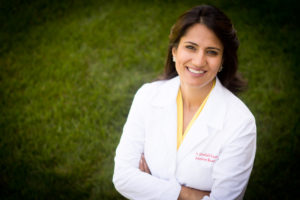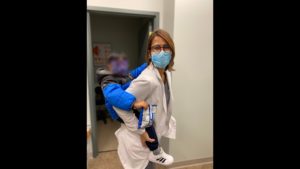April 1, 2022
By Shefali Miglani, OD
While there are no easy steps in the journey to managing myopia in very young children, I believe that by helping the parent, we can make an impact not only in the short term but also throughout the child’s life as they get older.
Surprisingly, I have been seeing a lot of really young children with progressive myopia since I started shifting my practice to myopia management specialty care a few years ago. It saddens me and shocks the parents because it feels like it comes out of nowhere.
One day, these young kids aged three and up are doing imaginary play with their toy dinosaurs, and the next, they are being fitted for blue child frames at their local optometry office. But this is a new reality that a lot of parents, along with their optometrists, are facing these days.
Taking good care of these young myopic children and, more importantly, the parents who care for them, requires a gentle and thoughtful approach. Here are some of the lessons and strategies that have helped me to manage very young myopic children, which may be valuable to help you in your myopia management practice.
Soothe the Shock and Anxiety of Parents
Most of the time, when it is discovered that the child has myopia, both parents get involved, not just one. They get worried because they don’t understand why this happens, so they both show up for the child’s exam.
After diagnosing and confirming the diagnosis of myopia (preferably with cycloplegic refraction), I physically turn around toward the parents sitting in the exam room chairs, get a bit closer to them, directly look at them, and tell them that it’s going to be okay. It’s just short of holding their hands, but getting physically closer builds trust, and building trust is critical when they are in shock and awe. It lets them put you in charge and takes a bit of responsibility off their shoulders.
I also do that by reassuring them that science has come a long way, and we now have tools to manage their child’s myopia effectively and comfortably. I also reinforce that early intervention is the key to slowing progression. While I don’t necessarily go into the details of the treatment options at the first visit because it can be too overwhelming, I touch on them and mention that they’ll be receiving several videos from the Hoot Myopia Care platform the next day or so. This commitment to sharing videos puts them at ease and continues to build trust.
One additional point here is that parents love written reports after each visit. Yes, I know it can be time consuming, but writing a short paragraph after each visit helps parents understand what’s happening with their child and what they can expect moving forward.
Get a Binocular Evaluation
Depending on my comfort level, I schedule a binocular evaluation either with myself or with a neighboring specialist OD. I feel that this step is essential in ruling out binocular vision issues that can contribute to learning issues and myopia progression in very young children.
I have had cases where patients enroll in vision therapy with an optometric colleague specialist and then start their myopia management journey in my practice. Also, I have had children perform those two treatment programs concurrently.
Building Rapport with the Child
Building trust with a very young child is as important as building trust with their parents. The success and the outcome of the treatment depend on the patient’s cooperation.
I do this by scheduling a follow-up Zoom call with the parents and the child where they get to see me smiling and encouraging. I try to speak to the child directly and ask them their interests, what they like to do, and how they like wearing glasses.
Research shows that being within four feet of someone’s personal space builds trust. In the exam room, where the face mask can interfere with a personal connection, a Zoom or FaceTime call allows me to be artificially close to them. The brain doesn’t know the difference in how that “close” space is created, and in today’s day and age of face masks, this is very pragmatic.
This video call allows the parents to absorb the information and gives them another opportunity to ask questions. It also allows the parents and the child to see me without the mask. Seeing each other’s faces will enable me to “read” the patients and parents better, and vice versa.
I usually introduce the treatment options at this call, briefly explain how each therapy works, and allow the parents and the children to give me feedback on which one they might choose.
Additionally, providing social proof to a young child is another powerful way to build rapport. We use the Hoot Myopia Care video testimonials or I&R training, which helps the child be more responsive. When kids see other kids doing great with orthokeratology or low-dose atropine, they start thinking, “Hey, if they can do it, then why can’t I?”
Optical Biometer Allows for Easier Measuring and Monitoring
At the formal consultations, both parents are invited with the child. At this point, I tailor the appointment to what option the parents and the child are leaning toward and what is indicated based on preliminary testing.
One of the most critical parts of this visit is performing optical biometry to measure the child’s baseline axial length. The intuitive reports from my Haag-Streit Lenstar Myopia biometer or the Tideman Axial Length graph on the Hoot Myopia Care website allow me to explain where the child is compared to “normative” data. This allows the parents to have a measurable perspective with their child. I also reinforce that axial length is an objective and independent way we can measure their child’s myopia progression.
Young kids can be a challenge to refract. The refractions can fluctuate, and most practicing doctors and families don’t have the time to cycloplege children at every follow-up visit. So, if you’re managing very young children’s myopia, consider purchasing an optical biometer.
Offer Behavioral Coaching at Every Visit
“What can we do at home, Doctor?” Parents often ask me this because they are looking to us for help to guide them on what to do at home, as they realize that life has changed these days. Whenever I ask about screen time or outdoor play, parents light up and encourage me to say more to their child in the hopes that I will be able to help the parent shift their child’s behavior.
To help make this easier, we share videos from the Hoot system with parents every month that cover topics such as:
- How we can reduce screen time
- Study posture
- Finding ways to play outside
- Using airplay mode on the tablet so they can read or play video games at a distance
- Lighting in the room when studying
- Parents’ own screen time and how that affects the child’s behavior
Whether you coach them live when parents and patients are in the office or send videos digitally, behavioral coaching is an essential component of how we’ve grown our myopia management practice, especially for the very young patient population.
While there are no easy steps in the journey to managing myopia in very young children, I believe that by helping the parent, we can make an impact not only in the short term but also throughout the child’s life as they get older.
 |
Dr. Shefali Miglani is the proud owner of Monroe Eye Care, where she specializes in myopia management for kids. As the Chief Medical Officer of Hoot Myopia Care, she helps to design and develop scientific protocols and parent-friendly content on myopia management for doctors on the Hoot platform. Dr. Miglani is a graduate of SUNY College of Optometry and received her undergraduate degree from Rutgers University, where she majored in Chemistry and Psychology. Together with her husband, she lives in a small town in New Jersey where they raise their three children.
Financial disclosure: Dr. Miglani is a paid consultant and speaker for Johnson & Johnson Vision Care.
|














